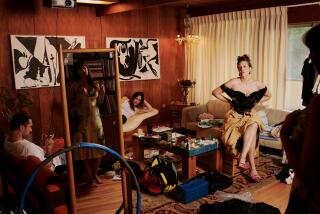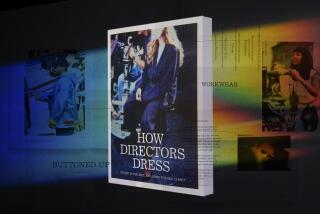Classic Hollywood: Edith Head, the best sort of designing woman
Eight-time Oscar-winning costume designer Edith Head once explained that what she did was a cross between “magic and camouflage. We create the illusion of changing the actors into what they are not.”
For more than five decades, Head was one of the cinema’s top costume designers, rising to the head of the costume department at Paramount, which was unheard of in the male-dominated studio system. When the studio didn’t renew her contract after 40 years, she moved to Universal, where she continued to work until her death in 1981 at 83.
Head was the favorite of many legendary directors, including Alfred Hitchcock (“To Catch a Thief,” “Rear Window,” “Vertigo”), Billy Wilder (“Sunset Boulevard”) and William Wyler (“The Heiress,” “Roman Holiday”). Actresses such as Barbara Stanwyck, Mae West, Audrey Hepburn and Grace Kelly wore her designs.
Head was a star in her own right, appearing on talk shows, commercials and even offering advice to housewives on the “Art Linkletter’s House Party.”
She’s now the subject of a new UCLA Film & Television Archive retrospective, “What I Really Do Is Magic: Edith Head and Hollywood Costume Design,” which opens Friday at the Billy Wilder Theater with her final film, Carl Reiner’s “Dead Men Don’t Wear Plaid,” released in 1982.
Other films in the series include 1933’s “She Done Him Wrong”; 1941’s “The Lady Eve”; 1953’s “Roman Holiday”; 1955’s ‘To Catch a Thief”; and 1950’s “Sunset Boulevard.”
Guests will include Reiner, costume designer Deborah Nadoolman Landis (“Raiders of the Lost Ark”), chair of UCLA’s David C. Copley Center for the Study of Costume Design; Paddy Calistro, who wrote “Edith Head’s Hollywood” with Head; and David Chierichetti, author of “Edith Head: The Life and Times of Hollywood’s Celebrated Costume Designer.”
“She was a self-made professional and self-made artist and did most of which she did out of sheer determination and application,” said UCLA’s Shannon Kelley, who programmed the series. “She came into costume design at a time when a lot of the point was to add value to the screen by means as elaborate as possible. I think her most distinctive contribution was to dress people like everyday American subjects.”
Head was not a trained designer. A French teacher in Hollywood, she had was taking some art classes in 1923 when she saw ad in the classifieds that Paramount was looking for someone to do sketch artist work for Cecil B. DeMille.
“She borrowed other people’s drawings, put them together in a portfolio and went to Paramount and applied for a job,” said Calistro, a former fashion writer at the L.A. Times.
Head wasn’t the greatest designer, said Calistro, “but none of the other designers were as smart as she was.”
Head, said Calistro, knew exactly how to work with stars, setting up her salon in such a way that “when a star walked in, those mirrors were placed perfectly, and the star was put in front of the mirror perfectly. Edith was dressed in gray, so she faded into the background. When the star saw her reflection in the mirror in her costume, she felt like the role.”
The designer also had a lot of tricks up her sleeve. The famous gown Kelly wears in “To Catch a Thief,” said Calistro, “really wasn’t that great except it was gold — a flashy, beautiful fabric that really photographs well. She picks a classic silhouette and sticks some birds on it and you have a winner. She always said if all else fails, put fur on it.”
Landis acknowledged her opinion of Head changed drastically over the years.
“When I started working at Universal in 1975, she didn’t have a very good reputation,” said the designer, who is married to director John Landis. “There was as an underlying feeling that she was taking credit for people’s work. She won an Oscar for ‘The Sting,’ and she didn’t thank enough people. So I didn’t make the most of the opportunity of being there. The feeling was that she was someone to be avoided.”
A few years later, they did chat at an exhibition at USC.
“She lived around the corner from me,” Landis said. “But I never extended myself. I was shy of her.”
But when she started reading her work and doing research for her PhD, Landis “realized how stupid I was not to get to know this remarkable person.”
Head, Landis noted, “understood better than anyone else that we design from the inside out, and she expressed and articulated as much. It was felt that what she was truly a genius at was self-promotion, when, in fact, if anyone had bothered to read her interviews, they would see she’s not talking about herself. She is doing her level best to explain what we do concisely and simply. She doesn’t even use her work as an example. It is not about the ‘I,’ it is about the ‘We.’”
------------
‘What I Really Do Is Magic: Edith Head and Hollywood Costume Design’
UCLA Film & Television Archive
Billy Wilder Theater
10899 Wilshire Blvd., Los Angeles
Aug. 8-Sept. 27
Admission: $8-$9
Information: https://www.cinema.ucla.edu
More to Read
Only good movies
Get the Indie Focus newsletter, Mark Olsen's weekly guide to the world of cinema.
You may occasionally receive promotional content from the Los Angeles Times.











